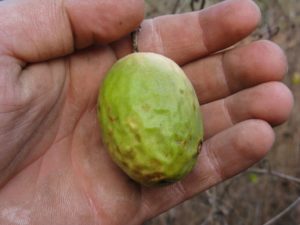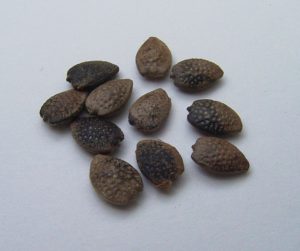 August: Maypops (Passiflora incarnata)
August: Maypops (Passiflora incarnata)
Our August Plant of the Month is maypops (Passiflora incarnata), so called because the fruit makes a loud popping sound when crushed. This vining plant with showy flowers is also known as passionflower or passionfruit, not because it stirs feelings of desire but because it reminded Spanish explorers of the Passion (Crucifixion) of Christ: the corona of purple petals are said to represent the crown of thorns worn by Christ and the five prominent stamens correspond to the five stigmata of the crucifixion. The Cherokees referred to maypops as “old field apricots”, which hints at the preferred habitat of Passiflora plants – they thrive in disturbed ground, such as roadsides, floodplains, and fallowed fields.
The ripened fruits are similar in size and color to apricots, ripening from green to shades of yellow and orange in late summer. The fruits have an edible pulp that can be scooped out and eaten, but each fruit also produces tens of large, woody seeds that are primarily discarded. These dimpled seeds preserve well in archaeological sites and have distinct dimples that makes identification of even small fragments of the seeds relatively easy.

In addition to eating the fruits raw, the Cherokees made a drink from “old field apricots”, scooping out the pulp and straining out the seeds. The juice was sometimes mixed with cornmeal or flour to thicken the drink. They also ate the leaves and young shoots of the plant, boiling them, frying them, and often mixing them with other greens. The Cherokees also made infusions from the roots to treat several ailments, including earaches, liver complaints, boils, and other skin inflammations. They also gave an infusion of the roots to babies to aid in the weaning process. The Houma of Louisiana also drank an infusion made from the roots as a blood tonic.
Even as tropical as they look, maypops are native to eastern North America, stretching from eastern Texas to the mid Atlantic Coast. Keep an eye out for these amazing flowers and ripening fruits as you walk or bike the greenways around Knox and Blount counties over the next couple of months!
For More Information:
Hamel, Paul B., and Mary U. Chiltoskey. 1975. Cherokee Plants and Their Uses – A 400 Year History. Herald Publishing, Sylva, North Carolina.
Moerman, Daniel E. 1998. Native American Ethnobotany. Timber Press, Portland, Oregon.
Perry, Myra Jean. 1975. Food Use of the “Wild” Plants by Cherokee Indians. Master’s thesis, University of Tennessee, Knoxville.
Speck, Frank G. 1941. A List of Plant Curatives Obtained from the Houma Indians of Louisiana. Primitive Man 14:49-75.
Witthoft, John. 1977. Cherokee Indian Use of Potherbs. Journal of Cherokee Studies 2(2):250-255.
US Department of Agriculture, Natural Resources Conservation Service. 2021. PLANTS Database. Electronic document, https://plants.usda.gov/home.